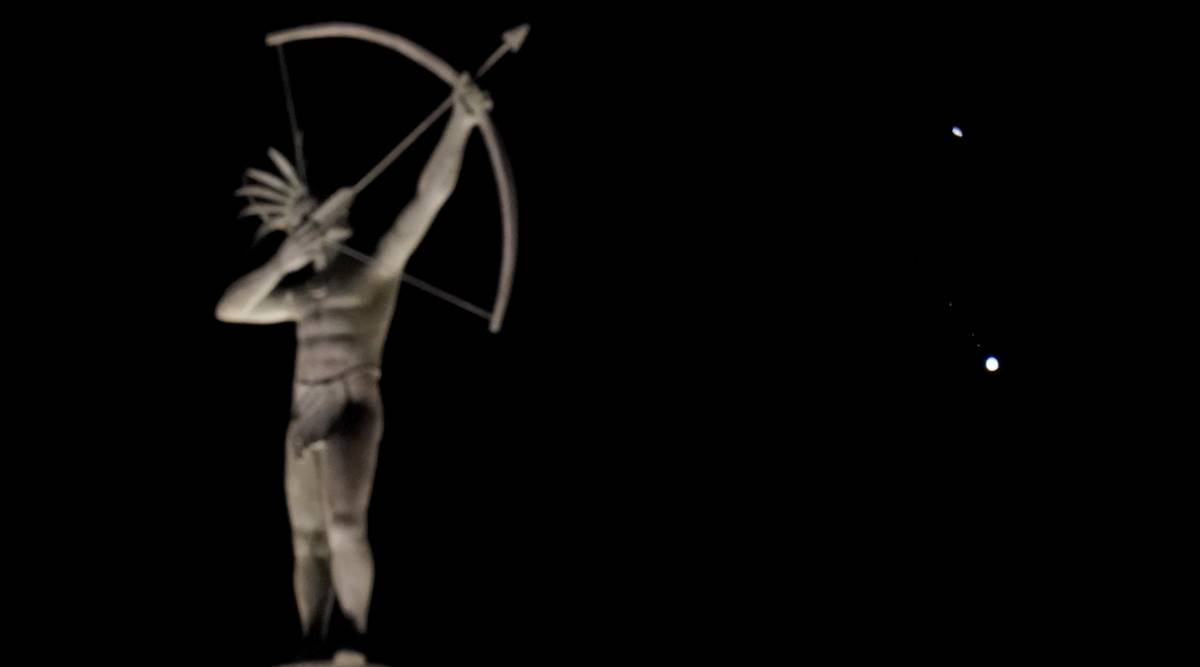 A statue of a Kansa Indian atop the Kansas Statehouse stands in the foreground as Saturn, top, and Jupiter, below, are seen Saturday, Dec. 19, 2020 in Topeka, Kan. (Source: AP)
A statue of a Kansa Indian atop the Kansas Statehouse stands in the foreground as Saturn, top, and Jupiter, below, are seen Saturday, Dec. 19, 2020 in Topeka, Kan. (Source: AP)Jupiter-Saturn Conjunction: Skygazers should be ready for the last and most prominent celestial event of the year 2020 as Jupiter and Saturn align in a way that they will appear as one bright star in the night sky on December 21, Monday. What makes this celestial event so special is that the two planets of our solar system will come close to the point that they will be separated by just one-tenth of a degree.
The two planets have not come closer than this since almost four centuries ago. On July 16, 1623, the two planets were 5’10” (five minutes 10 seconds) from each other compared to 6’06” of arc on December 21. There have been only two more instances where Jupiter and Saturn have come nearly as close as what we will witness this year.
“Conjunctions like this could happen on any day of the year, depending on where the planets are in their orbits,” said Henry Throop astronomer in the Planetary Science Division at National Aeronautics and Space Administration (NASA) Headquarters in Washington.
“The date of the conjunction is determined by the positions of Jupiter, Saturn, and the Earth in their paths around the Sun, while the date of the solstice is determined by the tilt of Earth’s axis. The solstice is the longest night of the year, so this rare coincidence will give people a great chance to go outside and see the solar system.”
How to watch Jupiter-Saturn conjunction?
To be able to witness this event, one does not need to have special equipment as it will be visible to the naked eye. You just need to wait for the sun to set, find an obstructed view of the sky and then look towards the southwest direction. To be able to view properly, make sure that the place you choose does not have too much light around.
As per NASA, Saturn will be slightly fainter as it will appear to be above the largest planet of our solar system towards the left. The positions will be reversed after December 21. To get a better view of the event, you will need binoculars or a place where there is a small telescope. This will not only give you a better view of the planets but the four moons orbiting around Jupiter.
If you are still not able to get a good look of the event, you can watch the live stream on NASA’s website or its Facebook and YouTube channels.
Express Tech is now on Telegram. Click here to join our channel (@expresstechie) and stay updated with the latest tech news.
© IE Online Media Services Pvt Ltd
![[WATCH VIDEO] Sophie Rain and sister Sierra Rain as Black Spiderman goes viral [WATCH VIDEO] Sophie Rain and sister Sierra Rain as Black Spiderman goes viral](https://www.sociallykeeda.com/uploads/images/202403/image_140x98_660976c59cce0.webp)





![[FULL WATCH VIDEO] Will Levis And Gia Duddy Leak Video Viral On Social Media [FULL WATCH VIDEO] Will Levis And Gia Duddy Leak Video Viral On Social Media](https://www.sociallykeeda.com/uploads/images/202405/image_140x98_6651e7ae8038d.webp)


